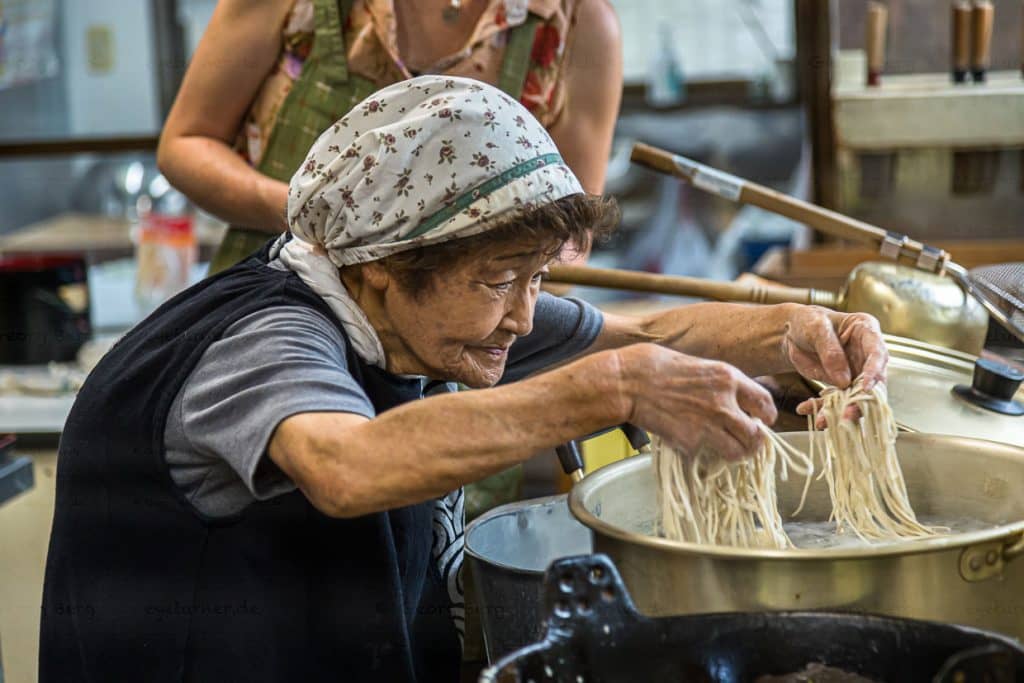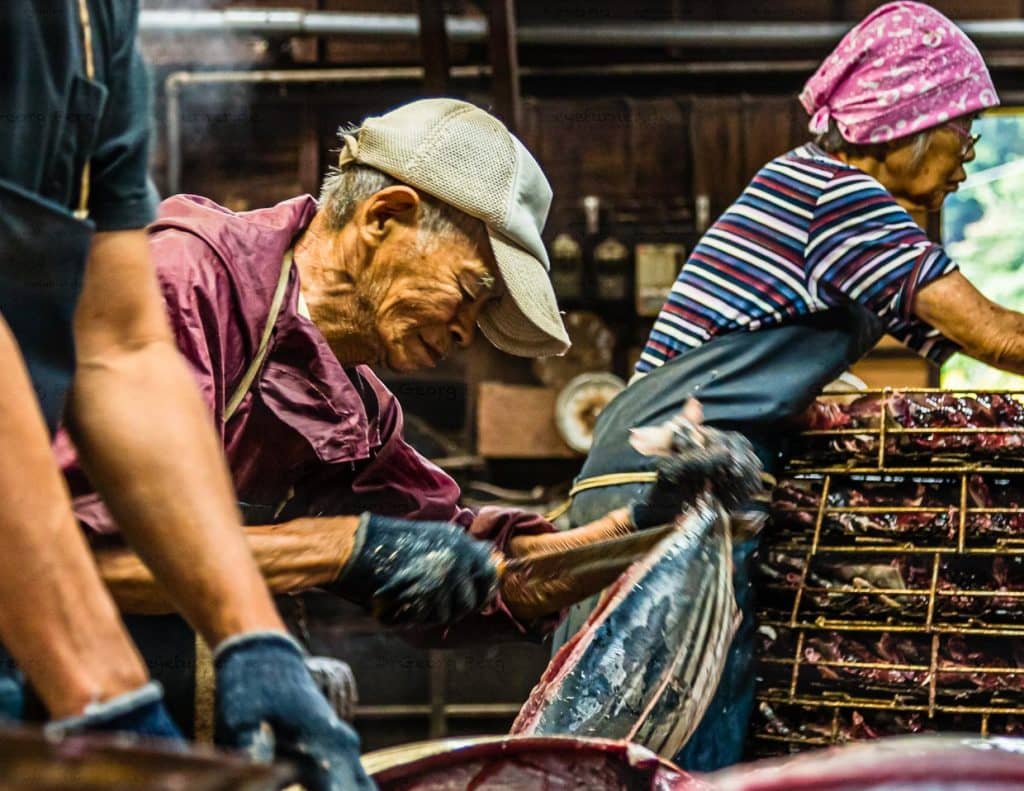On our journey through Shizuoka Prefecture, we repeatedly meet people who have dedicated their entire lives to their profession. They continue to contribute and pass on their skills well into old age. The Western credo of a work-life balance or the much longer described mid-life crisis, as a way out of which people turn to completely new life concepts, does not seem to be foreseen or even conceivable. Peter Rosei writes in his travel notes:“In the Japanese city, there are often still stores or crafts that exist in a kind of medieval self-sufficiency.” We also sense this frugality and contentment when we meet very different people and their trades.
A life for craftsmanship

Sumiko Sano is 85 years old, very friendly, hunched by age and very determined in her instructions when preparing soba noodles, the Japanese buckwheat noodles. She has been running the small restaurant in Yuno village at the foot of Mount Fuji for 28 years. At her place, the soba noodles are even cooked in the water of the holy mountain. Sumiko Sano took over the restaurant management from a lady who was also very old at the time. She is currently assisted by two women who are about twenty years younger and ready to take over the title and task in the near future. This has been going on here for generations. More precisely, for 19 genrerations – and buckwheat has been grown in Sumiko Sano’s family for 400 years.
Namagiri – The battle is never over

This Monday, the process from fish to flake begins anew. It’s been going on here for five generations and 138 years. Yasuhisa Serizawa’s manufactory sits inconspicuously in a curve on the way down to Tago Bay in the west of the Izu Peninsula. It is the beginning of a process based on the division of labor, in which everyone knows his place and his task. Everything begins with blood, water and fire. There is steam, water splashing from the hoses. The work surface is constantly being cleaned with a gush of fresh water. There is never any idle time. Each of the 15 or so employees knows what needs to be done.

In this clockwork of precision in processing some two tons of tuna, Yasuhisa’s father stands out. He has been producing katsuobushi, known to us as bonito flakes, for more than 60 years. He has run this business for many decades. Now in his old age, he just keeps going. Serizawa Senior also knows what to do. But he can no longer keep up the pace. He moves as if in slow motion, but at the same time with somnambulistic certainty. Without looking, he climbs over every water hose. Kneels down to light the fire for the first smoking process or cuts the fish in half. Later, he shows me photos from his active days. They are pictures of events where he is awarded for the particularly high-quality honkarebushi of his manufactory. Among them, however, is a photo from an amusement park that seems particularly important to him. Perhaps his only amusement outing?
Bonsai – in the garden of tamed worlds

Bonsai masters undergo a five-year apprenticeship. As a reward for the skills they have learned, they continue to work for their instructor for one year afterwards. As the owner of Gashouen Garden in Izu City, Shizuoka, Toshio Ohsugi owns many of his own bonsais. But a large number of the plants were given into care by their owners. He is vague about the value of the trees. Many are more expensive than a Mercedes Benz, he says. Often the bonsais are brought home by their owners for festivities. Owners of several bonsais change the plants from time to time due to lack of space in their own homes.

Give the bonsai a face
Every bonsai has a face. The parade side has the special attention of the bonsai master. The face of a bonsai leans slightly forward, toward the viewer. Careful pruning with tiny secateurs, trimming the roots or repotting are tasks of a bonsai master. In the summer months, the trees need to be watered twice a day. Evaluation such as sales and even bonsai rental are part of Toshio Ohsugi’s services. But what makes his job so special for him is the knowledge of the generations of bonsai masters before him who have had the same ancient dwarf tree in their care. He bears such a great responsibility, Toshio says, which makes him humble and grateful.

THANKS in Izu – From one who set out to become a baker
Daiichi Sugiyama wears a baker’s jacket with black-red-gold stripes. Dark breads with rye content and grain mixes are stacked in the display, and his house is unmistakably a tribute to German half-timbering. How did this happen? He answers us good-humoredly, using a mobile language translator with virtuosity.

Japanese are very fond of detail
Sugiyama says he completed his apprenticeship as a baker in Kiel. Since then, he has also worked with wholemeal flour and baked grain breads. He had his machines imported from Germany. The flours produced according to his ideas for Japan have names like Wilhelm and Hanse – and the bakery is even called DANKE. A German word that every Japanese understands. Incidentally, the Japanese arigato is also the word that every foreigner learns immediately. This is because Japanese say thank you so often that it is immediately internalized through constant repetition. The hearty breads are popular. However, more as a side dish for dinner. There is no bread in the Japanese breakfast of miso soup, pickled vegetables and fish.

Click here for a detailed report on soba, sake and satoyama
Click here for a detailed report on the traditional production of Katsuobushi

